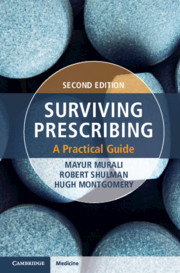Book contents
- Surviving Prescribing
- Reviews
- Surviving Prescribing
- Copyright page
- Contents
- Contributors
- Preface to the Second Edition
- Abbreviations
- Part 1 Introduction
- Part 2 Prescribing for Patient Groups
- Chapter 2 Prescribing in Renal Disease
- Chapter 3 Prescribing for Children
- Chapter 4 Prescribing for Older Patients
- Chapter 5 Prescribing in Pregnancy
- Chapter 6 The Basic Principles of Prescribing and Breastfeeding
- Chapter 7 Management of the Delirious (Acutely Confused) Patient
- Chapter 8 Prevention of Delirium Tremens and Management of Alcohol Withdrawal Syndrome
- Part 3 Emergency Prescribing
- Part 4 Gastrointestinal
- Part 5 Central Nervous System
- Part 6 Haematology
- Part 7 Surgery
- Part 8 Diabetes
- Part 9 Calculations
- Part 10 Interactions, Hypersensitivity and Contraindications
- Part 11 Infections and Other Important Topics
- Index
Chapter 2 - Prescribing in Renal Disease
from Part 2 - Prescribing for Patient Groups
Published online by Cambridge University Press: 08 June 2020
- Surviving Prescribing
- Reviews
- Surviving Prescribing
- Copyright page
- Contents
- Contributors
- Preface to the Second Edition
- Abbreviations
- Part 1 Introduction
- Part 2 Prescribing for Patient Groups
- Chapter 2 Prescribing in Renal Disease
- Chapter 3 Prescribing for Children
- Chapter 4 Prescribing for Older Patients
- Chapter 5 Prescribing in Pregnancy
- Chapter 6 The Basic Principles of Prescribing and Breastfeeding
- Chapter 7 Management of the Delirious (Acutely Confused) Patient
- Chapter 8 Prevention of Delirium Tremens and Management of Alcohol Withdrawal Syndrome
- Part 3 Emergency Prescribing
- Part 4 Gastrointestinal
- Part 5 Central Nervous System
- Part 6 Haematology
- Part 7 Surgery
- Part 8 Diabetes
- Part 9 Calculations
- Part 10 Interactions, Hypersensitivity and Contraindications
- Part 11 Infections and Other Important Topics
- Index
Summary
Kidneys are sensitive to damage by drugs, with up to 20% of episodes of drug-induced acute renal failure. New prescribers must be able to identify these patients and eliminate these risks when possible; avoid potentially nephrotoxic drugs; and adjust drug doses in patients, where necessary, in those with pre-existing renal impairment to avoid drug accumulation and toxicity. This chapter identifies high-risk drug classes to avoid in renal failure, top tips to avoid drug toxicity, how to treat patients in chronic renal failure and provides a quick reference guide for drug dose reduction in those with renal impairment.
- Type
- Chapter
- Information
- Surviving PrescribingA Practical Guide, pp. 5 - 16Publisher: Cambridge University PressPrint publication year: 2020

